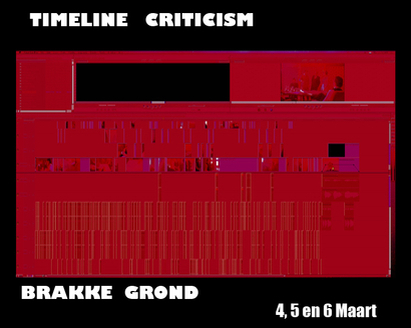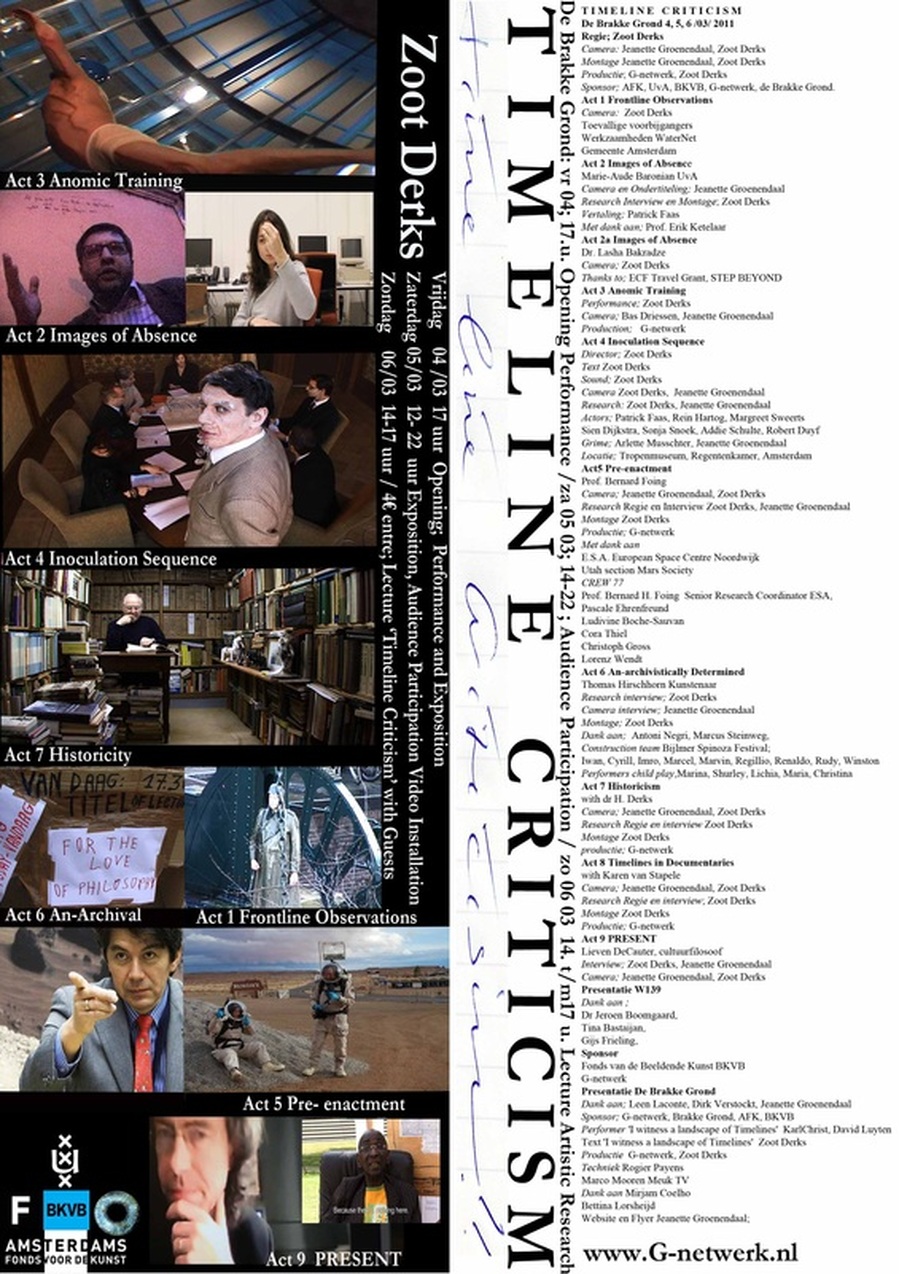Synopsis
The final installment of the trilogy Archival Fields, in which experimental filmmaker and researcher Zoot Derks questions the use of technological timelines in a philosophical and artistic way. What kind of consequences does the use of such programmed timelines have, which place video images in a historical context and in doing so create an instant past, or "pastness"? Derks invites the audience to participate in his performative video installation, which will stretch out through the staircases, hallways and side rooms of the Flemish art center De Brakke Grond, questioning the editing of video images. The filmmaker will use the material he shot for the first two parts of the trilogy, PolderPiece and Timeline Criticism, as well as new material shot during IDFA. He will discuss his subjects with specially invited guests and random passersby. Central to the discussions will be the concept of "suture," which can mean the same thing as "editing" but can also be translated more literally as "sewing," or more theoretically as "a break in the prevailing discourse." Together with the audience, Derks will walk the tightrope between these various meanings and the dividing line between word and image.
Credits
Director Zoot Derks
Photography Zoot Derks, Jeanette Groenendaal
Editing Jeanette Groenendaal, Zoot Derks
Production Zoot Derks
Jeanette Groenendaal for G-netwerk
Contact | Advertising
Click here to edit.
Video essays to be uploaded after premiere
'Timeline Criticism'
De Brakke Grond 4,5, and 6 march 2011
(NL)
Timeline Criticism De Brakke Grond
Artistiek Onderzoek video-installatie en lezingen door Zoot Derks
4 maart 17:00 uur opening performance and exposition
5 maart 14-22 uur Publieks participatie video installatie
6 maart 14- 17 uur 'Timeline Criticism' Lecture Artistic Research with Guests
Een gigantische decor, een ‘format’ achter creaties, een monade type systeem.
Stelt u zich een landschap voor van ontelbare tijdlijnen, waarin het behoud van alle belangrijke aspecten van het onderliggende systeem type in beeld zijn.
Hoe bevraagt U dit nieuwe gelaagde landschap van tijdlijnen?
Is een mogelijke dubbele clash tussen immobiele en mobiele werelden van tijdlijnen,
een crash tussen teleologische bepaalde tijdsbestekken versus Deleuziaanse vloeibare tijd,
een steeds maar vernieuwende verworvenheid?
Wat gebeurt er als een tech-tijdlijn binnendringt in artistieke ruimte en praktijk?
Ons dagelijks leven lijkt een imbricate van dit overlappend landschap, een regelmatig patroon van al deze tech-tijdlijnen.
Waarom gebruiken we technologische tijdlijnen, die het verleden, of 'verledenheid' maken,
of dat wat is, in een historische context plaatsen,
wat betekenen deze activiteiten in het landschap van archieven?
Thanks to: G-netwerk, Jeanette Groenenedaal, Marie Baronian, Bernard Foing, Borka Paviceciv, Lasha Bakradze,Thomas Hirschhorn
Patrick Faas, Sien, Ad, Addi Schulte, Sonje Snoek, Robert Duyf, Margreet Zweerts, Arlette Muschter, e.v.a.
Welcome!
(EN)
Timeline Criticism DE BRAKKE GROND, Amsterdam
Artistic Research Video Installation and Lectures
By Zoot Derks
4 maart 17:00 uur opening performance and exposition
5 maart 14-22 uur Publieks participatie video installatie
6 maart 14- 17 uur 'Timeline Criticism' Lecture Artistic Research with Guests
A giant backdrop, a creation behind creations, a monad type system. Imagine a plane of innumerable timelines preserving all significant aspects of the underlying type systems. How to question this new layered landscape of timelines? Is a possible dual clash between immobile/ mobile worlds of timelines, a crash between determined teleological time frames, versus Deleuzian fluidity of time like a becoming? What happens if a tech-timeline intrudes artistic space and practice? Our daily lives seem imbricate with an overlapping in a regular pattern of all these tech-timelines. Why do we use technological timelines that render the past, or pastness, or that which is put in a historical context, through operations in the archival?
Thanks to: G-netwerk, Jeanette Groenenedaal, Marie Baronian, Bernard Foing, Borka Paviceciv, Lasha Bakradze,Thomas Hirschhorn
Patrick Faas, Sien, Ad, Addi Schulte, Sonje Snoek, Robert Duyf, Margreet Zweerts, Arlette Muschter, e.v.a.
Welcome!
Timeline Criticism De Brakke Grond
Artistiek Onderzoek video-installatie en lezingen door Zoot Derks
4 maart 17:00 uur opening performance and exposition
5 maart 14-22 uur Publieks participatie video installatie
6 maart 14- 17 uur 'Timeline Criticism' Lecture Artistic Research with Guests
Een gigantische decor, een ‘format’ achter creaties, een monade type systeem.
Stelt u zich een landschap voor van ontelbare tijdlijnen, waarin het behoud van alle belangrijke aspecten van het onderliggende systeem type in beeld zijn.
Hoe bevraagt U dit nieuwe gelaagde landschap van tijdlijnen?
Is een mogelijke dubbele clash tussen immobiele en mobiele werelden van tijdlijnen,
een crash tussen teleologische bepaalde tijdsbestekken versus Deleuziaanse vloeibare tijd,
een steeds maar vernieuwende verworvenheid?
Wat gebeurt er als een tech-tijdlijn binnendringt in artistieke ruimte en praktijk?
Ons dagelijks leven lijkt een imbricate van dit overlappend landschap, een regelmatig patroon van al deze tech-tijdlijnen.
Waarom gebruiken we technologische tijdlijnen, die het verleden, of 'verledenheid' maken,
of dat wat is, in een historische context plaatsen,
wat betekenen deze activiteiten in het landschap van archieven?
Thanks to: G-netwerk, Jeanette Groenenedaal, Marie Baronian, Bernard Foing, Borka Paviceciv, Lasha Bakradze,Thomas Hirschhorn
Patrick Faas, Sien, Ad, Addi Schulte, Sonje Snoek, Robert Duyf, Margreet Zweerts, Arlette Muschter, e.v.a.
Welcome!
(EN)
Timeline Criticism DE BRAKKE GROND, Amsterdam
Artistic Research Video Installation and Lectures
By Zoot Derks
4 maart 17:00 uur opening performance and exposition
5 maart 14-22 uur Publieks participatie video installatie
6 maart 14- 17 uur 'Timeline Criticism' Lecture Artistic Research with Guests
A giant backdrop, a creation behind creations, a monad type system. Imagine a plane of innumerable timelines preserving all significant aspects of the underlying type systems. How to question this new layered landscape of timelines? Is a possible dual clash between immobile/ mobile worlds of timelines, a crash between determined teleological time frames, versus Deleuzian fluidity of time like a becoming? What happens if a tech-timeline intrudes artistic space and practice? Our daily lives seem imbricate with an overlapping in a regular pattern of all these tech-timelines. Why do we use technological timelines that render the past, or pastness, or that which is put in a historical context, through operations in the archival?
Thanks to: G-netwerk, Jeanette Groenenedaal, Marie Baronian, Bernard Foing, Borka Paviceciv, Lasha Bakradze,Thomas Hirschhorn
Patrick Faas, Sien, Ad, Addi Schulte, Sonje Snoek, Robert Duyf, Margreet Zweerts, Arlette Muschter, e.v.a.
Welcome!
*Act 1 Frontline Observations. Act 1 Frontline Observations. (video archive production)
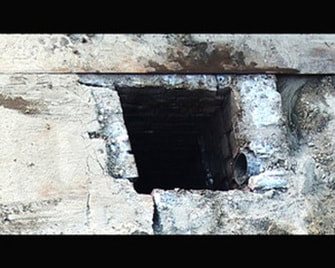
Act 1 Frontline Observations. (video archive production)
Direct counter-video observations and surveillances video strategies from my studio window; capturing the world as it (dis) appears, every day for a period of one year.
I discovered numerous incidents where the camera captured peoples producing fiction (in staged street photo sessions, staged street film sets) I spotted a Nazi actor under a fake rain shower on the bridge, an impersonator of the late neder-blues singer Andre Hazes, fashion shoots, tourist lenses, the floating by of seasonal events.
Not without alienation, I monitored time and at the same time the ongoing over-budgeted city-work in front of my door; the Sewerage Disposal Service was intensively renovated for protection against future flooding (see Act 4).
Direct counter-video observations and surveillances video strategies from my studio window; capturing the world as it (dis) appears, every day for a period of one year.
I discovered numerous incidents where the camera captured peoples producing fiction (in staged street photo sessions, staged street film sets) I spotted a Nazi actor under a fake rain shower on the bridge, an impersonator of the late neder-blues singer Andre Hazes, fashion shoots, tourist lenses, the floating by of seasonal events.
Not without alienation, I monitored time and at the same time the ongoing over-budgeted city-work in front of my door; the Sewerage Disposal Service was intensively renovated for protection against future flooding (see Act 4).
*Act 2 Images of the Absence.*Act 2 Images of the Absence. (video lecture on archival gap)
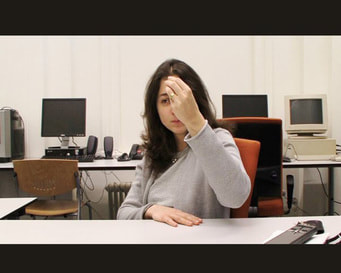
*Act 2 Images of the Absence. (video lecture on the archival gap)
Lecture on dynamics of appearing and disappearing of images in archival fields, which are never neutral acts, there is always an element of power. Marie Baronian articulates the paradoxical political aspects of the un-archived (hidden) Armenian holocaust and ‘the Armenian ‘cry’ for an actual archive.
Act 3 Anomic Training. Act 3 Anomic Training. (body with floating monitor)
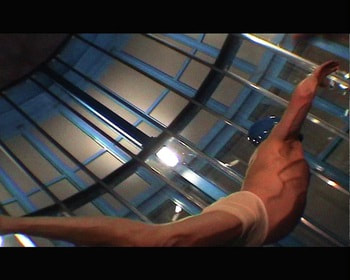
Act 3 Anomic Training. (my body with floating camera)
The Archival questions the images of control. What is a precise moment, the archeology, the un-indexical moment, free flowing in libidinal energies as proposed by Deleuze and Guattari? My body itself is the historical construct, with layers of reification and power inscriptions (Foucault).
*Act 4 Inoculation Sequence, *Act 4 Inoculation Sequence,
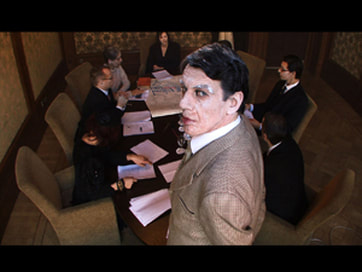
*Act 4 Inoculation Sequence,
Re-enactment. This play is based on real meetings, and on original minutes written during preparations for Waterworks in the Netherlands. (Flevo-polder 1938). The script for eight actors was rewritten from remains of partly burned archives of this board meeting. This sequence is shot at its historical location, the Regenten Kamer in the Amsterdam Tropical Museum.
POLDERPIECE (act 4, scene3: The Souther Sea Gathering)
Actors; Margreet Sweerts, Sonja Snoek, Rein Hartog, Ad, Addie Schulte, Robert Duijf, Sien, Patrick Faas
Director/ script/ concept/camera/ sound/ composition/ editing; Zoot Derks
Assistant, second camera; Jeanette Groenendaal
Production; G-netwerkGrime, costumes; Arlette Muschter, Jeanette Groenendaal
Re-enactment. This play is based on real meetings, and on original minutes written during preparations for Waterworks in the Netherlands. (Flevo-polder 1938). The script for eight actors was rewritten from remains of partly burned archives of this board meeting. This sequence is shot at its historical location, the Regenten Kamer in the Amsterdam Tropical Museum.
POLDERPIECE (act 4, scene3: The Souther Sea Gathering)
Actors; Margreet Sweerts, Sonja Snoek, Rein Hartog, Ad, Addie Schulte, Robert Duijf, Sien, Patrick Faas
Director/ script/ concept/camera/ sound/ composition/ editing; Zoot Derks
Assistant, second camera; Jeanette Groenendaal
Production; G-netwerkGrime, costumes; Arlette Muschter, Jeanette Groenendaal
*Act 5 Pre- enactment, *Act 5 designing future archives; collaboration Jeanette Groenendaal.
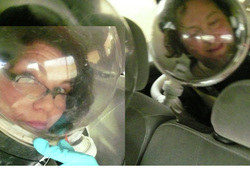
Act 5 designing future archives; in collaboration with artist Jeanette Groenendaal.
The PolderPiece video research ventures into un-chartered territory. Invited by Mr. Bernard Foing to participate in Crew 77 of the EuroGeoMars Project, ESA research team in the desert of Utah, USA. In the ‘as if situation’ ESA scientists used performance methods to conduct research. To act as if we actually ‘Are’ and ‘Live’ on Mars, playing astronauts, future subjects.
Are we preparing the ‘end’ of the archive? Are we leaving earth ‘as it is’, by way of a Kantian ‘fresh start’, built an (holy) Arch of all rational, indefinite trust in the exo-terrestrial future, in dialectics of domination and exclusion?
The PolderPiece video research ventures into un-chartered territory. Invited by Mr. Bernard Foing to participate in Crew 77 of the EuroGeoMars Project, ESA research team in the desert of Utah, USA. In the ‘as if situation’ ESA scientists used performance methods to conduct research. To act as if we actually ‘Are’ and ‘Live’ on Mars, playing astronauts, future subjects.
Are we preparing the ‘end’ of the archive? Are we leaving earth ‘as it is’, by way of a Kantian ‘fresh start’, built an (holy) Arch of all rational, indefinite trust in the exo-terrestrial future, in dialectics of domination and exclusion?
*Act 6 Not an-archivalisticly determined *Act 6 Not an-archivalisticly determined,
(a videoimpression)
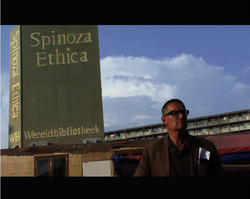
*Act 6 Not an-archivalisticly determined, (a video-impression)
Talk with the artist Thomas Hirschhorn about his Spinoza Bijlmer Festival, and about his problem of being described as ‘an-archival artist’ by a famous American art-critic Hal Foster.
Talk with the artist Thomas Hirschhorn about his Spinoza Bijlmer Festival, and about his problem of being described as ‘an-archival artist’ by a famous American art-critic Hal Foster.
The Best of Both Worlds
Graduation Show of the Master Artistic Research of the Universiteit van Amsterdam
Opening: W139, Friday 30 January 21.00 pm
The University of Amsterdam launched a Masters in Artistic Research in 2007, for students with a BA in fine art, music, dance or theatre. The Masters programme offers a combined theory/practice study. The first of the MA graduates will be presenting work in W139.
Zoot Derks, Joa Hug, Zbigniew Maciak, Imke Ruigrok and Vital Stahievitch will present work at W139 on Thursday 19 February. An evening with shows, performances and a lecture.
Presentation: Thursday 19 February 20.00 until 23.00 pm
W139, Warmoesstraat 139, 1012 JB Amsterdam, www.w139.nl
The Master Artistic Research is a collaboration between the Amsterdamse Hogeschool voor de Kunsten, the Gerrit Rietveld Academie and the Universiteit van Amsterdam. The exhibition is sponsored by W139 and the Fonds BKVB.
Your browser does not support viewing this document. Click here to download the document.
